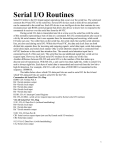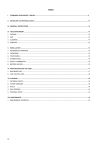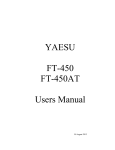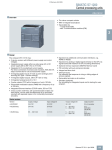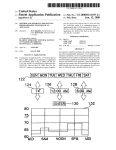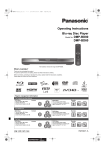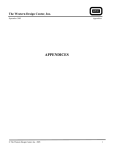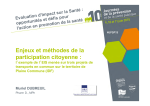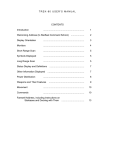Download Radio Shack TRS-80 III Owner`s manual
Transcript
Bedlam ™ ® A DIVISION OF TANDY CORPORATION FORT WORTH, TEXAS 76102 Bedlam Program: ©1982 Robert Arnstein Licensed to Tandy Corporation All Rights Reserved. Bedlam Program Manual: ©1982 Tandy Corporation. All Rights Reserved. Reproduction or use, without express written permission from Tandy Corporation, of any portion of this manual is prohibited. While reasonable efforts have been taken in the preparation of this manual to assure its accuracy, Tandy Corporation assumes no liability resulting from any errors or omissions in this manual, or from the use of the information obtained herein. Please refer to the Software License on the back cover of this manual for limitations on use and reproduction of this Software package. 10 9 8 7 6 5 4 3 2 1 Introduction Bedlam is another new adventure from Radio Shack. There are no hidden treasures to find, no wealth to amass, no score to beat. There is only one goal–get out, if you can. Your success depends totally upon your resourcefulness and your ability to think clearly. There is always one way out, but be warned–the exit changes each time you load the game, Your computer and the instructions you give are the keys to your escape. Bedlam recognizes commands like GO WEST or GET THE KEY. You can shorten direction commands to WEST or NORTH (or even W or N if you prefer). You don't have to limit yourself to two-word commands. You can HIT THE DUMB DOOR WITH THE STUPID KEY, or EXAMINE THE GREEN DOOR. (If there are two doors or two keys present, the computer might ask WHICH DOOR? or WHICH KEY?) Add the missing word (including a space at the end of the word). You may end a game at any time by holding down the [BREAK] key while you press the Reset button. You can erase anything you type by pressing the [CLEAR] key or using the [\À\] and [\Â\] arrow keys. If you are in the middle of a sentence, the computer will make room for any new text. To make the computer respond to your request, you must press the [ENTER] key after you type your instruction. To help you escape, you can try enlisting the aid of some of the people you meet. Just remember where you are. Can a man running around painting doors on walls and claiming to be Picasso really help? Can a man who says he is Houdini get you out? What about using "X-Ray" Johnson to burn a hole in the wall to gain freedom? Perhaps the guard dog just needs a little attention. Maybe the nurse or the doctor with the hypodermic needle (if he really is a doctor) can be persuaded to help you. Their ability to help also changes each time you load the game. Depending on the active escape route, you will either be able to escape without help from anyone, or you will need help from one or more of the people you meet. Some of the inhabitants of Bedlam are neither friendly nor cooperative. They do not get along with other inmates and some will try to stop you from leaving. The people that can help in one game may be ineffective in another game. If you want an inmate to take an action, type the inmate's name and the action you wish taken (for example, MERLIN MEET HOUDINI or HOUDINI OPEN THE GREEN DOOR). Some escape routes are not as obvious as others. If you get lost during a game, type: [L][O][O][K] and press [ENTER] to see where you are. To take an inventory of what you have acquired during the course of the game, type: [I][N][V][E][N][T] (short for Inventory) and press [ENTER]. 1 There are times during the game when you might be in serious danger. One particular resident of Bedlam can create problems, which only a well-timed [P][L][U][G][H] can cure. You must choose your allies wisely from among the people you meet. Good Luck. I really hope you make it. Who knows? You may even be lucky the first couple of times and get out easily. You may not be quite so lucky the next time you try to escape. 2 System Requirements To run Bedlam, you will need the following equipment: Model I • A Radio Shack 16K Level II TRS-80 Microcomputer • A Radio Shack Cassette Recorder and Connecting Cable Model III • A Radio Shack 16K Model III TRS-80 Microcomputer • A Radio Shack Cassette Recorder and Connecting Cable Loading Instructions Model I/III It is assumed you have reviewed the general operational procedure for your equipment as explained in your TRS-80 Owner's Manual, Computer Cassette Recorder Manual, and the Cassette Information Sheet, which is enclosed with this package. You should now be aware of how to turn on your computer and load tapes. Note: If you are using a system with a disk drive, instructions are provided at the end of this section for converting Bedlam to a disk file. To use Bedlam as a cassette program, hold the BREAK key down while turning on the system. Make sure your Bedlam cassette program tape is fully rewound and the "Play" key is down on the recorder. Turn on the system. If you are not familiar with the equipment, please refer to your Owner's Manual. The screen will show: You type: Cass? (Model III only) Memory Size? READY >_ Press [H] Press [ENTER] *?_ [S][Y][S][T][E][M] and press [ENTER] [B][E][D][L][A][M] and press [ENTER] After the program loads*, the screen will show: *?_. Type [\/\] and press [ENTER]. 3 *Note: If C* appears in the upper right corner of the screen, turn the computer off, turn up the cassette volume a little, then repeat the loading instructions. After the program is loaded, rewind the program tape and remove it from the recorder. Note for Model III Users Only Extreme caution should be used when executing the [\/\][ENTER] . Failure to release the [ENTER] key quickly will result in turning the cassette recorder on and the program will not start. If the program does not function, rewind the program tape, then repeat the loading instructions. 4 Converting Bedlam to Disk (For Advanced Users Only) Bedlam is designed to operate in the low 16K of RAM. This is also the area where TRSDOS loads. (That's why you have to prevent DOS from loading by holding down the [BREAK] key when loading a cassette tape into a disk system.) To use the program from diskette, you must use DEBUG (plus TAPE and RELO for Model III users) to enter one or two machine language programs to first move Bedlam up above TRSDOS (to store it), then move Bedlam down (to play the game). Model I Insert a TRSDOS diskette in Drive m. Insert the Bedlam tape into the cassette recorder. Make sure the cassette is fully rewound and the "Play" key is down. Press the Reset button on the TRS-80. DOS READY will appear on the screen. Type: [D][E][B][U][G] and press [ENTER]. DOS READY will reappear. Press the [BREAK] key to enter the DEBUG mode. The screen will fill with numbers and letters. From this point on, do not press any key unless you are told specifically to do so. To make this next portion easier to use, we will go to a different DEBUG screen. Press the [S] key once. The screen now looks a bit less cluttered. Type: [D][8][0][1][0] and press the space bar once. The line you just typed (D8010) told the DEBUG utility that you wanted to Display the portion of memory that contains the address 8010. In the left column, look at 8010 (the second line from the top of the screen). The horizontal line of numbers (to the right of 8010) must be changed. Type: [M][8][0][1][0] and press the space bar once. The M (in front of the number just typed) told DEBUG that you wanted to Modify memory, starting at address 8010. Notice vertical lines appeared on either side of the first two digits after 8010. Address 8010 presently contains a two digit hexidecimal value. In the blank area at the lower left corner of the screen, you will see: 8010 00←(The two digit number may not be 00 depending on what programs you may have run recently.) Each digit can be any number between 0-9 or the letters A-F. DEBUG uses the dash (-) to ask what this value should be changed to. The space bar is used in DEBUG to store changes. [ENTER] is only used to leave the Modify mode. Do not press Enter unless specifically told to do so. Type the following line exactly (remember to press the space bar once after each pair of digits): 21 00 43 11 20 80 01 00 3D ED B0 C3 00 00 5 You can now press the [ENTER] key to leave the Modify mode. Look at the line and compare it to the line above. If you find you've made a mistake, type: [M][8][0][1][0] and press the space bar once to re-enter the Modify mode. You can simply press the space bar till the pair of vertical lines are positioned on either side of the incorrect entry. Type the correct two digits and press the space bar to store the change. After the changes are made, press [ENTER] to exit the Modify mode at this address. There is one more program left to write. Type: [D][B][D][3][0] and press the space bar to Display the part of memory containing the starting address DB30 (the fourth line from the top of the screen. Next, type the Modify command: [M][B][D][3][0] and press the space bar. Here are the new values that must be entered for each line. The markers will drop to the next line automatically as you finish each line. Remember to press the space bar after each two digits. BD30 BD40 BD50 BD60 F3 F1 40 20 AF 06 C3 80 21 27 75 11 D2 12 00 00 06 13 3E 43 11 10 07 01 00 FC 32 00 40 AF 1D 3D 01 32 40 ED 36 1D 21 B0 00 40 E3 C3 ED 21 03 00 B0 3D 3D 20 54 BD 22 16 22 16 40 21 43 Press [ENTER] to exit the Modify mode. Check the changed lines carefully. If there are any errors, go back to Modify (MBD30, MBD40, MBD50, or MBD60) and make any changes. You can press the space bar to skip the correct portions of the line. Press [ENTER] to exit the Modify mode at this section of memory. You are now finished with DEBUG. (You've just written two machine language relocation programs—Congratulations!!) While holding down the [BREAK] key, press the Reset button to go to BASIC. Press [ENTER] to answer the MEM0RY SIZE? question. At READY >_,type [S][Y][S][T][E][M] and press [ENTER]. *?_ will appear. Type [B][E][D][L][A][M] and press [ENTER]. The Bedlam program tape will start to load. After Bedlam is loaded, *?_ will reappear. Type [/][3][2][7][8][4] and press [ENTER]. The computer will return to DOS READY. At DOS READY, type the following line exactly, without spaces (except for the two spaces shown: DUMP BEDLAM/CMD (START=X'8020',END=X'0BD3F',TRA=X'0BD30') and press [ENTER] . The Bedlam program will be transferred to diskette (under the file name, BEDLAM/CMD). To run Bedlam, just type [B][E][D][L][A][M] and press [ENTER] at DOS READY. 6 Model III Insert a TRSDOS diskette in Drive 0. Insert the Bedlam tape into the cassette recorder. Make sure the cassette is fully rewound and the "Play" key is down. Press the Reset button on the TRS-80. TRSDOS Ready will appear on the screen. Type: TAPE (S=T,D=D) and press [ENTER]. Press [H] in response to the Cass? question. The screen will show: Device = Tape to Disk Press ANY key when Cassette ready Press the [ENTER] key. The recorder will start and in a moment, you will see the word BEDLAM at the bottom of the screen. The loading ** will flash in the upper right corner of the screen. After Bedlam is saved to disk, TRSDOS Ready will reappear. Type: RELO BEDLAM/CMD (ADD=8020) and press [ENTER]. After TRSDOS Ready appears, type: LOAD BEDLAM/CMD and press [ENTER]. After TRSDOS Ready reappears, type: [D][E][B][U][G] and press [ENTER]. The screen will fill with numbers and letters. From this point on, do not press any key unless you are told specifically to do so. Press [M]. The program will respond with M ADDRESS? =. Type: [B][D][3][0] and press the space bar once. The M (in front of the number just typed) told DEBUG that you wanted to Modify memory, starting at address BD30. Look at the fourth line from the top of the screen. Notice the solid white block over the first two digits (after BD30). Address BD30 presently contains a two digit hexidecimal value. You are going to change that value and the value of the numbers that follow. [ENTER] is used to leave the Modify mode. Do not press Enter unless told to do so. Type the following line exactly, without any spaces. (The numbers are shown here separated in groups of four for ease of entry, since that is how they appear on the screen): 7 F321 2080 1100 4301 003D EDB0 C300 43 Look at the line and compare it to the line above. If it's correct, you can press [ENTER] to leave the Modify mode. If you find you've made a mistake, you can simply use the arrow keys to move the white block over to where it is covering the incorrect entry. Make any corrections needed. Press [ENTER] to exit the Modify mode. You are now finished with DEBUG. (You've just written a machine language relocation program—Congratulations!!) Press [Q] for Quit to go to TRSDOS Ready. At TRSDOS Ready, enter the following line exactly without any spaces (except for the two spaces shown: DUMP BEDLAM/CMD (START=8020,END=0BD3F,TRA=0BD30) and press [ENTER]. The Bedlam program is now properly moved to diskette under the file name, BEDLAM/CMD. To run Bedlam, just type [B][E][D][L][A][M] and press [ENTER] at TRSDOS Ready. 8 IMPORTANT NOTICE ALL RADIO SHACK COMPUTER PROGRAMS ARE LICENSED ON AN "AS IS" BASIS WITHOUT WARRANTY. Radio Shack shall have no liability or responsibility to customer or any other person or entity with respect to any liability, loss or damage caused or alleged to be caused directly or indirectly by computer equipment or programs sold by Radio Shack, including but not limited to any interruption of service, loss of business or anticipatory profits or consequential damages resulting from the use or operation of such computer or computer programs. NOTE: Good data processing procedure dictates that the user test the program, run and test sample sets of data, and run the system in parallel with the system previously in use for a period of time adequate to insure that results of operation of the computer or program are satisfactory. RADIO SHACK SOFTWARE LICENSE A. Radio Shack grants to CUSTOMER a non-exclusive, paid up license to use on CUSTOMER'S computer the Radio Shack computer software received. Title to the media on which the software is recorded (cassette and/or disk) or stored (ROM) is transferred to the CUSTOMER, but not title to the software. B. In consideration for this license. CUSTOMER shall not reproduce copies of Radio Shack software except to reproduce the number of copies required for use on CUSTOMER'S computer (if the software allows a backup copy to be made), and shall include Radio Shack's copyright notice on all copies of software reproduced in whole or in part. C. CUSTOMER may resell Radio Shack's system and applications software (modified or not, in whole or in part), provided CUSTOMER has purchased one copy of the software for each one resold. The provisions of this software License (paragraphs A, B, and C) shall also be applicable to third parties purchasing such software from CUSTOMER. RADIO SHACK A DIVISION OF TANDY CORPORATION U.S.A.: FORT WORTH, TEXAS 76102 CANADA: BARRIE, ONTARIO L4M 4W5 TANDY CORPORATION AUSTRALIA BELGIUM U.K. 280-316 VICTORIA ROAD RYDALMERE, N.S.W. 2116 PARC INDUSTRIEL DE NANINNE 5140 NANINNE BILSTON ROAD WEDNESBURY WEST MIDLANDS WS10 7JN Printed in U.S.A.














